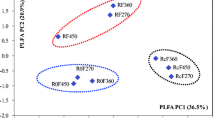Abstract
We have measured the rates of respiration over a period of 13 days (304.5 h) at 90-min intervals for two contrasting soils amended with nothing, d-glucose, l-alanine, albumin, starch, d-glucose plus l-alanine, d-glucose plus albumin, l-alanine plus starch or albumin plus starch at 2 mg each individual substrate per gram soil. These treatments represent simple and complex model substrate additions with widely different C:N ratios and enable investigation of the interaction between substrates as they induce microbial respiratory responses. When added singly, the times taken for the maximum respiratory response to occur were less than 15 h for d-glucose, approximately 50 h for l-alanine and approximately 120 h for albumin. Addition of starch alone did not lead to a respiratory response within 304.5 h (13 days). The peak respiratory response from soils amended with l-alanine plus d-glucose was advanced by between 6 and 13 h depending on the soil compared with either substrate added singly. The patterns of respiratory response from soil amended with d-glucose plus albumin were similar to that predicted by the summed data, implying no interaction. The addition of l-alanine plus starch and of albumin plus starch led to increased respiratory responses, implying that the nitrogenous substrate facilitated the utilisation of starch by the soil micro-organisms.




Similar content being viewed by others
References
Anderson JPE, Domsch KH (1978) A physiological method for the quantitative measurement of microbial biomass in soil. Soil Biol Biochem 10:215–221
Bremer E, Kuikman PJ (1994) Microbial utilisation of 14C[U]-glucose in soil is affected by the amount and timing of glucose additions. Soil Biol Biochem 26:511–517
Degens BP, Harris JA (1997) Development of a physiological approach to measuring catabolic diversity of soil microbial communities. Soil Biol Biochem 29:1309–1320
Demetz M, Insam H (1999) Phosphorus availability in a forest soil determined with a respiratory assay compared to chemical methods. Geoderma 89:259–271
Duah-Yentumi S, Rønn R, Christensen S (1998) Nutrients limiting microbial growth in a tropical forest soil of Ghana under different management. Appl Soil Ecol 8:19–24
Garland JL, Mills AL (1991) Classification and characterisation of heterotrophic microbial communities on the basis of patterns of community-level-sole-carbon-source utilisation. Appl Environ Microbiol 57:2351–2359
Hopkins DW, Webster EA, Chudek JA, Halpin C (2001) Decomposition in soil of tobacco plants with genetic modifications to lignin biosynthesis. Soil Biol Biochem 33:1455–1462
Ladd JN, Jocteur-Monrozier L, Amato M (1992) Carbon turnover and nitrogen transformations in an Alfisol and a Vertisol amended with [U-14C]glucose and [15N]ammonium sulfate. Soil Biol Biochem 24:359–371
Marstorp H (1996) Interactions in the microbial use of soluble plant components in soil. Biol Fertil Soils 22:45–52
Nannipieri P, Johnson RL, Paul EA (1978) Criteria for measurement of microbial growth and activity in soil. Soil Biol Biochem 10:223–229
Nordgren A (1988) Apparatus for the continuous, long-term monitoring of soil respiration rate in large numbers of samples. Soil Biol Biochem 20:955–957
Nordgren A (1992) A method for determining microbially available N and P in an organic soil. Biol Fertil Soils 13:195–199
O'Dowd RW, Hopkins DW (1998) Mineralization of carbon from d- and l-amino acids and d-glucose in two contrasting soils. Soil Biol Biochem 30:2009–2016
Stotzky G, Norman AG (1961) Factors limiting microbial activities in soil. I. The level of substrate, nitrogen, and phosphorus. Arch Microbiol 40:341–369
Swift MJ, Heal OW, Anderson JM (1979) Decomposition in terrestrial ecosystems. Blackwell, Oxford
Tsai C-S, Killham K, Cresser MS (1997) Dynamic response of microbial biomass, respiration rate and ATP to glucose additions. Soil Biol Biochem 29:1249–1256
Webster EA, Chudek JA, Hopkins DW (2000) Carbon transformations during decomposition of different components of plant leaves in soil. Soil Biol Biochem 32:301–314
Acknowledgements
This work was supported by a grant from the joint British Council and the Italian MIUR-CRUI (Ministero dell'Istruzione, dell'Università e della Ricerca, and Conferenza dei Rettori delle Università Italiane) collaborative research programme, the UK Natural Environment Research Council and the Royal Society of London.
Author information
Authors and Affiliations
Corresponding author
Rights and permissions
About this article
Cite this article
Meli, S.M., Badalucco, L., English, L.C. et al. Respiratory responses of soil micro-organisms to simple and complex organic substrates. Biol Fertil Soils 37, 96–101 (2003). https://doi.org/10.1007/s00374-002-0570-5
Received:
Accepted:
Published:
Issue Date:
DOI: https://doi.org/10.1007/s00374-002-0570-5




